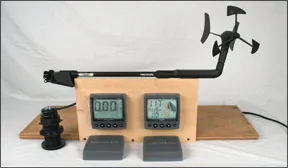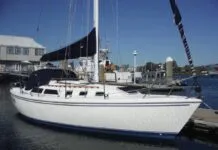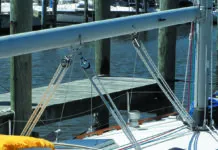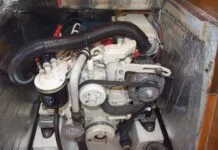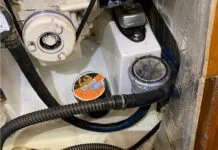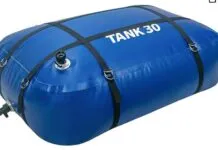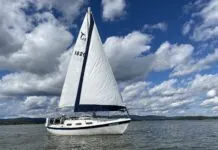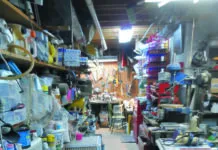Few things are as frustrating as trying to run a new wire through a boat. Unless the builder had the foresight to include some messenger lines for later installations, adding a new device is enough to send anyone running for the nearest wireless solution. But wireless devices have their own issues that can offset any time saved during installation.
Practical Sailor
What We Tested
Here, then gone, now back again, Nexus Marine earned Best Buy kudos in our May 1999 review of integrated instrument systems. Nexus was the marine-manufacturing arm of Swedish compass maker Silva, and for the first half of this decade, Nexus-made equipment bore the Silva and then Nexus brand. When Gerber Legendary Knives (part of the multinational Finnish company Fiskar), acquired Silva in 2006, Nexus re-emerged as an independent company. This year, it was purchased by New Zealand-based KIWI Yachting Service. The units are still made in Sweden and distributed in North America by Comnav Marine Ltd., a privately held Canadian company in business since 1983.
Founded by two brothers, Clive and Mark Johnson, Tacktick developed a popular wireless compass in 1996 and is regarded as one of the pioneers in wireless onboard instrumentation. In 2003, the company introduced its Micronet system, an innovative, mostly solar-powered wireless networking system that was named a Practical Sailor Gear of the Year in 2004. The company has a range of wireless and wired systems, ranging in price from $600 to over $2,000. This year, Tacktick was acquired by Finnish company Suunto.

How We Tested
Using the provided manuals and equipment, testers set up each unit on temporary mounts, which were then fixed to one of our test powerboats for evaluation. The mast mounts were checked for fit on a Seldn mast. The Tacktick system was later installed on an ODay Javelin to evaluate race functions.
The displays were evaluated for ease of use and visibility in both day and night using the backlighting settings.
Wind sensors were taken on the highway and subjected to apparent wind speeds of 60 knots. The displays were sprayed with jets of water for five minutes, and both displays and servers were placed in an autoclave at 140 degrees for 30 minutes; then, they were run through performance tests again.
The Tacktick display, because it is designed to be portable, was dropped once on each side onto a fiberglass deck from 3 feet.
Except where noted, both systems proved very stable and performed all their advertised functions without hiccups. The chief differences were in the ease of installation, quality of the display, ease of use, and in the quantity and type of data available. Specifications and performance ratings are reflected in the Value Guide on page 28.
Nexus Start Pack 3
This network-capable system features two 4.3-by-4.3-inch display units (sea data and wind data), a black-box server, a wind sensor, and an Airmar tri-data transducer to record speed, temperature, and depth. Its $1,625 price makes it a very attractive option for the sailor looking to upgrade his cockpit instrument package. It is also available with separate Airmar 52-mm depth and speed transducers at the same price.
While the Tacktick Race Master system can run entirely on solar power, the Nexus Start Pack 3 requires a 12- or 24-volt power supply for everything but the masthead unit, which has a built-in solar panel. The design we tested featured a striking horizontal-axis sensor with a twin-fin vane design. Any difference in the sensitivity of this design as compared to conventional single-fin designs was not apparent during testing.
Apart from a few printing and editing hiccups, the Nexus installation guide is complete and easy to follow.
Having two distinct displays, each with its own set of five buttons, simplifies choosing functions. Each unit displays two user-programmed functions, a main function at the top of the screen, and a sub-function at the bottom. The sea-data display can show wind data as well as the basic speed and depth functions.
The wind sensor, which includes a built-in barometer, does a good job of tracking speed and direction. The wind data display is divided vertically, presenting an analog graphic view of wind data on the right-hand side and digital data on the left side. When sailing close-hauled, the analog display can be configured to indicate wind shifts as little as 1.66 degrees. An internal computer uses wind and speed data (either from the log or a networked GPS) to calculate velocity made good (VMG). The user can determine what wind data-average wind speed, average wind angle, true wind speed, true wind angle, etc.-can be digitally displayed alongside the analog view.
The Nexus system is fairly easy to calibrate and has a greater range of flexibility when it comes to choosing the sampling rate for wind and sea data. Testers liked the Nexus backlighting and range of functions, even though it does not have some of the specialized race functions found in the Tacktick Race Master System.
Nexus offers clear advantages for cruisers. It has three possible depth alarms allowing you to easily track coastal depth contours, or set an anchor alarm. There are connections for an external alarm that can be mounted in the cabin of a bigger boat. It also offers a greater networking capability with the addition of the NX2 server, about $850, which is required to interface with autopilots, plotters, or computer navigation software. (Tackticks networking system, Tacktick Micronet system can be interfaced in this way.)
Bottom line: For the money, we found the NX Start Pack to be a solid contender in the field of sailing instrument systems. Its cruiser-oriented features make it a more versatile choice for someone who wants to cruise as well as race.
Tacktick
Introduced in 2007, the Race Master Series is a multifunction (compass, wind, depth) unit that is principally marketed to the sport-boat segment. The system can be powered either by 12-volt or solar power. The Race Master that Practical Sailor tested came with a depth sounder and wind sensor and internal compass.
The LCD display is designed for cockpit or mast mounting, with two 3.5-by-2.5-inch screens, angled slightly so that the helmsman and crew can clearly see either screen from an outboard position or from near the boats centerline. Two solar panels in the top of the unit provide power and charge the internal batteries. One nice advantage of this stand-alone system is that it can be easily snapped out of its bracket and stored out of the weather when not in use.
Like the Nexus, each screen can be split horizontally to show two sets of data. Supplementary data, like wind shifts and line bias (the favored side of a start line), is graphically revealed in a bar graph on the side of the display screen. The display unit, which is submersible, is rated with a battery life of 300 hours at its brightest backlighting. After a one-day charge, we got three days of use before getting the low battery warning. Tacktick recommends a 12-volt power source for cruising.
The wind sensor uses a cupped anemometer and a single-fin vane sensor. The cups are rubberized and can stand up to a fair amount of abuse.
The supplied Airmar knot-log, temperature, and speed transducer is the same as that used by Nexus. The knot log and temperature sensor performed flawlessly, but the depth indicator provided spotty returns, later remedied by relocating the temporarily-mounted transducer out of any turbulence. The transducer is hard wired to a small 4-by-4-inch splash proof module with the obligatory itsy-bitsy connectors. No strain-relieve clips are provided. The transducer is powered by a small 3.5-by-3.5-inch solar panel, which has a 10-foot length of wire for remote mounting.
Tackticks users guide didnt match the Nexus literature, but its Quick Start Guide was helpful for initial trials.
Once you become familiar with the “chapter” and “pages” organization, interface is fairly simple. Flipping through the functions became a whole lot easier when we made a laminated copy of the chapter and page organization chart from the Users Guide.
Unique to the Tacktick is a bar-graph that appears on the side of the display to graphically represent data. After you go through a pre-race setup procedure, the indicator lets you quickly see which is the favored end of the start line, track how far off dead-downwind you are, and when you should jibe for optimal velocity made good.
By setting the mean wind direction (MWD) before the race, you can track wind shifts on the course. Along with tracking wind shifts, the Tacktick also provides the ability to see how close you are to a target trim boat speed, which can be automatically calculated from a rolling average or manually locked. During our single-handed small-boat sea trials, we longed for the optional wireless remote ($750), so we could flip through all of these functions, some of which are pages deep.
After a long period of dormancy, the wireless wind sensor and the display had to be re-connected by the auto network process. This requires dropping the mast or going aloft.
Bottom line: For sport-boat racers who don’t want to fuss with mast wires, the Tacktick Race Master is a useful, albeit expensive, addition to the arsenal. Cruisers will want to look at the Tacktick Micronet system, which is more easily expandable. For the dead-serious racer, Tackticks new Dual Maxi display and GPS, with even more race features (distance to start line, accelerate/decelerate, tack to tack calibration, etc.) has eclipsed the Race Master.
Conclusion
Both of these systems are fairly straightforward to set up and use, although the Nexus, in part because of its twin display setup, was the easier to master. Tacktick, with its many options for tracking performance on the course in real time, would be our pick for those serious about improving race performance. Its ability to work without a 12-volt system makes it the clear choice for small-boat racers.
The versatile, expandable Nexus, with its intuitive interface and analog representation, was impressive. It provides all the basic functions a cruiser or racer uses most, and the analog wind display appealed to our analog brains.
Despite the advantages of a wireless mast indicator, we are not sold on this arrangement. Yes, it makes installation easier, but it also introduces a battery, an independent charging system, and a radio transmitter/receiver, all possible failure points. The only failure point it eliminates is the wired connections, fairly easy items to troubleshoot. If we had an average size boat that presented no great challenges to a wired system, wed opt for a wired arrangement.
Wireless is nice. Wireless is convenient. But sometimes its better to spend the extra time installing a robust system with wired connections. Practical Sailor will be looking at some of the new wired systems in an upcoming article.
last looked at some of the latest developments in wireless systems in 2004, just as the Tacktick Micronet system, a compact system featuring wireless display and masthead sensor, was earning a strong following among racers. This month, Practical Sailorrevisits wireless wind instruments with a comparison of Tackticks improved Race Master system and the NX Start Pack 3, a hybrid wired/wireless instrument system from Nexus.
